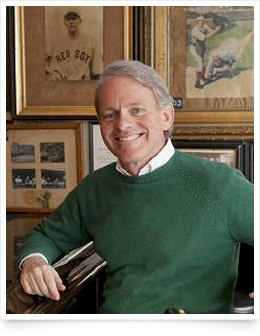Playing Hardball
A new book from CGS prof and political pundit Tom Whalen chronicles the early dynasty of the Boston Red Sox.
“I get a lot of hate mail,” says CGS Associate Professor Tom Whalen. One of Boston University’s most sought-after experts on American politics, Whalen is frequently quoted in news outlets such as The Economist, The Washington Post, The Boston Herald, CNN, and NPR. His regular commentary on Politico, in particular, generates a range of heated reader responses. Whalen has also written books about politics and the personalities involved. Two of his best known are Kennedy versus Lodge: The 1952 Massachusetts Senate Race and A Higher Purpose: Profiles in Presidential Courage.
But Whalen isn’t only a professor of social science; he’s also a Boston sports fan. Several years ago he blended his love of local sports lore with his interest in social history in Dynasty’s End: Bill Russell and the 1968–69 World Champion Boston Celtics. Now he’s done it again, in an upcoming book tentatively titled Birth of a Red Sox Nation.
Sports reflect the broader culture in any period, Whalen says. “Russell once said the three main collective activities people have taken part in throughout history are sports, politics, and religion. When you think about it, it’s true; there’s always some kind of organized game, organized religion, and organized political system in our society.”
“Particularly in a place like Boston,” says Whalen, a native of the area. “The Red Sox, sports—it’s in our cultural DNA. We have a long, rich history.”

Cheap beer, bigotry, and fisticuffs
The focus of Whalen’s book is the early heyday of the Boston Red Sox, who won Major League Baseball’s first-ever World Series in 1903, then four more championships between 1912 and 1918. “Outside of the Yankees, no other team has won that many in so short a period,” Whalen points out. “That accomplishment kind of cemented the Red Sox’s hold on fans for generations.”
It was also a team whose very origin lay in conflict. Whalen explains, “When the American League was founded in 1901, it wasn’t supposed to put a team here in Boston,” per a gentlemen’s agreement. “But then the National League took steps to preemptively destroy the American League, so the AL president, Ban Johnson, basically said, ‘Screw them, I’m gonna put a team in Boston.’ That’s why we got the Red Sox: revenge!”
The upstart Americans (as they were generally called until 1908) “stole a bunch of players from the cross-town National team, made the ticket prices lower, and the beer prices lower,” Whalen recounts. “The gate attraction was there from the beginning.”
The two rival leagues soon struck a truce, settling more or less into today’s modern system, with a single commissioner and, of course, a World Series by 1903. But division remained a theme in the Red Sox clubhouse, even as the team reigned on the field.
Tris Speaker, the club’s star centerfielder from 1908 to 1915, was one of the greatest all-around players of all time, says Whalen. “He had the same lifetime batting average as Ted Williams, and the same defensive stats as Willie Mays. And he was a quick runner: he stole 52 bases in 1912, a record that stood until Tommy Harper broke it in 1969.”
“And meanwhile,” Whalen adds, “he was a member of the Ku Klux Klan.”
At that time, the KKK—led by a native of Speaker’s hometown of Hubbard, Texas—was becoming increasingly mainstream, feeding on Americans’ fears of a Catholic immigrant takeover. A young man then, Speaker had never met a Catholic he didn’t dislike. He made no exceptions for his own teammates. Fistfights often broke out. Speaker even brawled with the manager, Bill “Rough” Carrigan, “who was known as ‘Rough’ for a reason,” says Whalen.
“Speaker was tight with Smoky Joe Wood, the star pitcher,” Whalen says. “They led the Protestants on the team, who were known as the ‘Mason’ faction, and they didn’t get along with the Catholics on the team, who were nicknamed ‘the Knights of Columbus.’ That included Carrigan, Duffy Lewis, and also Babe Ruth.
“In one account I came across, a club insider said Speaker went an entire season without speaking to Duffy Lewis,” his fellow star of “The Golden Outfield.”
That sectarian strife, says Whalen, “completely mirrored what was happening in Boston at that time. The Brahmin establishment was being eclipsed by Catholics, particularly the Irish, who were on the rise politically—that’s where the Kennedys came from. In fact, JFK’s grandfather Honey Fitz [John F. Fitzgerald], who had become mayor by then, threw out the first pitch at Fenway Park’s inaugural game in 1912. He even tried to buy the club at one point.”
And on the paternal side of the late president’s family, says Whalen, “JFK’s father, Joe Kennedy, played baseball at Boston Latin School and lettered in it at Harvard. The Irish were strongly associated with baseball because it was considered a way of climbing up a step in the world. And it was a major entertainment of the Irish community,” typified by “‘Nuf Ced’ McGreevy, the local tavern owner, and his Royal Rooters, the Red Sox fan club.”
Curses!

Whalen chronicles the Red Sox’s move to Fenway Park, when the club was owned by Boston Globe publisher General Charles Taylor and run by his son. “John Taylor was a screw-up,” says Whalen with a laugh. “He was like the George W. Bush of the family. ‘Oh yeah, let him run this baseball team.’ But he made some money for them when he built the Park and sold the team to Joseph Lannin. . . It was a nice real estate deal.”
The new owner, Whalen argues, made the truly pivotal trade in Red Sox history, and he was behind the more notorious deal that followed it. “The Tris Speaker trade was more important than the Babe Ruth trade.”
Lannin traded Speaker to Cleveland in 1916 after a salary dispute. “This was the opening Babe Ruth was waiting for,” says Whalen. Young Ruth was an outstanding left-handed pitcher—he pitched 29 and two-thirds consecutive scoreless World Series innings—but “he always loved to hit, and he pressured managers to put him in more games [as an outfielder] when he wasn’t pitching.”
Without Speaker’s offensive firepower in the lineup, Carrigan granted Ruth his wish. By 1918, Ruth’s at-bats nearly tripled—and his RBIs more than quadrupled. In 1919, his last season with the Sox, Ruth hit 29 home runs—unheard of in what was also the last year of the “dead-ball era,” when the spitball was legal and scores were low.
Then, Whalen contends, “Lannin inadvertently caused the Ruth trade.” He had sold the team to “the infamous Harry Frazee” in 1916, accepting an IOU for half the sale price, Whalen explains. By 1919, Frazee still owed $250,000 to Lannin, “and Lannin applied pressure, forced Frazee to come up with the money. Where could Frazee go? He went to Jake Ruppert, owner of the Yankees.” Frazee sold Ruth to Ruppert for $125,000. “So Lannin was responsible for the two trades that had the biggest repercussions for the club for generations.”
Aftermath
Everybody knows the Red Sox wouldn’t win another World Series for 86 years after that. However, Whalen points out, the Babe wasn’t the only star Boston let slip through its fingers: “The Sox had the first crack at Jackie Robinson, and at Willie Mays. Imagine that: We would have won a few World Series in the ’50s!” Instead—again reflecting ethnic divisions in the city at large—Tom Yawkey’s Red Sox were the very last major league team to integrate, signing their first black player, Pumpsie Green, in 1959.
“It wasn’t the ‘Curse of the Bambino,’” says Whalen. “It was the curse of bad management and racism that did in the Sox for so long.”
 One Fashionable Summer An internship at Allure magazine taught Skylar Shapiro the ins and outs of fashion publishing.
One Fashionable Summer An internship at Allure magazine taught Skylar Shapiro the ins and outs of fashion publishing. Going Their Own Way Alumni Peter Ross and Nick Riotto launched a company that connects kids with summer camps. And they did it on their own terms.
Going Their Own Way Alumni Peter Ross and Nick Riotto launched a company that connects kids with summer camps. And they did it on their own terms.